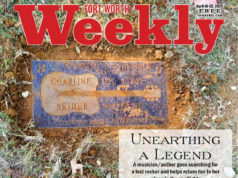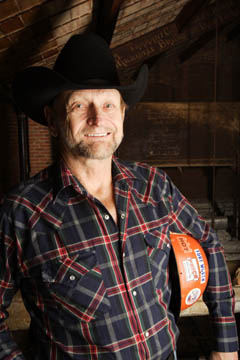 Both kneecaps were broken, his back was injured, and one finger was partly severed. In the chaos of the high-steel construction site, it was hours before another crane could be brought to move him – and even then it couldn’t reach him.
Both kneecaps were broken, his back was injured, and one finger was partly severed. In the chaos of the high-steel construction site, it was hours before another crane could be brought to move him – and even then it couldn’t reach him.
But a fellow ironworker could. “This fellow Ted Dunham, well, he picked me up in his arms like a baby and carried me across an 8-inch beam for 35 feet, 180 feet off the ground to that crane, and they got me down,” Smith recounted. “He saved my life.”
High-steel workers like Smith and Dunham tell those kinds of stories the way other people talk about twisting an ankle at the gym. They look down – figuratively as well as physically – on the rest of us regular mortals from perches high above the city. And there are lots of them up there these days. The building boom in Fort Worth and the rest of North Texas has brought ironworkers in from all over the country. The city’s skyline is being redrawn by guys who are very different from the yuppies and office workers who will inhabit the places they’re building. They seem like figures from a different era, when strength and physical courage were what it took to get the job done, and a much higher percentage of workers were nomads going wherever the jobs were.
Still, they are largely an anonymous group. The only famous ironworkers are the Mohawk Indians who built so much of New York City and the unnamed group of men whose likenesses were captured in Charles Ebbets’ dizzying 1932 photograph, taken as the men casually ate lunch while sitting on a girder of New York’s Rockefeller Center, 69 floors above the ground.
Almost all the high-steel workers are men, who pride themselves on their ability to work in difficult positions under adverse conditions. “I guess some people think we’re different,” said David Chrietzberg, who hung steel for six years during the 1980s until he broke his back on the job. “For the most part, ironworkers are a pretty good bunch of guys. Probably a raunchy bunch to a lot of people because they like to drink and raise hell, but they get the job done.”
Like the job at the Tarrant County Courthouse about 25 years ago. Chrietzberg’s name is one of five written on a 6-by-40-foot beam that helps hold up the roof. The workers signed it when they helped renovate the courthouse. The beam was put in place sometime in 1895 by some of Fort Worth’s earliest ironworkers. “Can you imagine how many tons a beam like that weighs?” Chrietzberg said. “They had mules and pulleys dragging that up wooden scaffolding, But there weren’t any cranes to hold it in place. That was just hard, backbreaking iron work. And it still is.” The man who wrote the names was Doug “Superman” Reynolds. Ironworkers seem to acquire nicknames as readily as wrestlers, and it’s a tradition among ironworkers to sign their names on the top beam of a building so that the crews who eventually come to tear it down will know who put it up there. In the 1981-82 renovation, the guys from Ironworkers Local 263 didn’t put the huge beam in place, but they did hang a lot of steel, in what turned out to be a tougher job than projects much higher in altitude and profile.
“We still earned it,” said Reynolds, who was given his nickname because of his extraordinary strength. “And it was the highest beam we could sign.” “That was a near-impossible job,” said Leroy Self, a foreman of one of the renovation crews, whose name is also on the beam. “We started from the ground floor and worked our way to the top. Everything was rotten.”
The work was difficult, the men explained, because so much of the work had to be done old-style. Steel beams weighing thousands of pounds were hoisted up by crane to a 36-inch-wide window in the cavernous courthouse attic just below the bell tower, then pulled inside and put in place by hand. “There was just no way to get machinery in there,” said Self, now retired. “On top of that, there was no place to walk in that attic. We had to plank and scaffold everything or we’d have fallen through to the floor below. So we’d be walking on tiptoe carrying 3,000-pound beams. We were lucky to have Superman with us.”
In the courthouse basement, Self said, the crews had to open up an old elevator shaft and a tunnel that ran “from the old jail to a hanging tree in the park across the street. … I found shoes and stuff in the bottom of the elevator shaft that were probably 100 years old.” The finds led to a prank. “I told someone we’d found a three-dollar gold piece down there. Wasn’t two hours later when here came the project manager telling us anything we found belonged to the county. And he came back over the weekend with a metal detector. Spent all weekend and found 21 cents. He was madder than hell.” Self, an ironworker from 1963 until an on-the-job shoulder injury took him out of the game in 1990, said that while he worked heights sometimes, it wasn’t his favorite job. Ironworkers hundreds of feet up in the air help crane operators move massive beams around, getting them exactly placed so that they can be bolted together – work that often doesn’t leave any hands to hold on with.
“You know, if you’re connecting beams vertically, you’re just out there,” he said. “You’ve got to shimmy up that beam and wait for the crane to bring the next one in. Then you’ve got to get it into position so that the bolt holes line up. Then you take your spud wrench – a steel bar with a point at one end and a wrench on the other – and put it through the holes in the beams so they line up. Then you put a bolt or two in place, shimmy up higher and stand on the two ends of that spud wrench and wait for the next beam. “Some guys, like Rattlesnake Smith, they were superhuman way up there, but I loved life just a little more than that.” “Rattlesnake wasn’t just fearless, he was crazy,” said Steve Anthony, business agent of Ironworkers Local 263. “Hell, yes, he could walk a beam way up there, but he was just crazy. When we were in apprentice school together, he got mad at one of the teachers and let a whole box of rattlesnakes loose on the floor. I’m still mad at him for that.”
Smith, who led a second crew on the courthouse renovation, laughed about the story of how he got his nickname. “I guess some things will always come back to haunt you,” he said. Now 66 and still in good shape, he explained that he used to run rattlesnake roundups and that he happened to have a footlocker filled with about 35 of the venomous buzzers in his truck one day at apprentice school – or “punk school,” as the men call it. “I was late, and the welding teacher did something that got me so mad, I just went out and got that locker and dumped those snakes all over the classroom. You never saw grown men jump onto tables and chairs so quick.” Smith, who said he rounded up the snakes before anyone got hurt, is a second-generation high-steel worker. His father and brother were in the business as well. “I’ve traveled all over the U.S. hanging steel,” he said. “It’s kind of a family thing.”
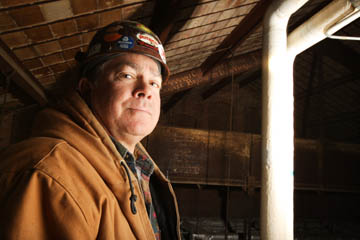 For Smith, hanging steel was a joy. “You either love it or you get out,” he said. “It’s hard work. It’s dangerous work. The most intimidating thing is the weather.” In the winter, he said, ice sometimes builds up two inches thick on the beams. “And you can’t just quit working, because you’ve got to meet the general contractor’s deadlines. So you chip away at the ice and go out and work on the beams. If you can’t do that, you’re in the wrong business.” But whereas the thought of working unharnessed on icy steel beams hundreds of feet off the ground would give most people the willies, it gave Smith an adrenalin rush. “You get up there 30 or 40 stories and walk out on a 4-inch beam – well, it’s a feeling like you’ve never had in your life. The higher I got, the better I felt about myself – the freer I was. You look down at that street and those tiny people, and you know you are doing a job that very few people can do. You are the king of the world. “At the same time, you never know when a gust of wind is going to come along and take you with it.”
For Smith, hanging steel was a joy. “You either love it or you get out,” he said. “It’s hard work. It’s dangerous work. The most intimidating thing is the weather.” In the winter, he said, ice sometimes builds up two inches thick on the beams. “And you can’t just quit working, because you’ve got to meet the general contractor’s deadlines. So you chip away at the ice and go out and work on the beams. If you can’t do that, you’re in the wrong business.” But whereas the thought of working unharnessed on icy steel beams hundreds of feet off the ground would give most people the willies, it gave Smith an adrenalin rush. “You get up there 30 or 40 stories and walk out on a 4-inch beam – well, it’s a feeling like you’ve never had in your life. The higher I got, the better I felt about myself – the freer I was. You look down at that street and those tiny people, and you know you are doing a job that very few people can do. You are the king of the world. “At the same time, you never know when a gust of wind is going to come along and take you with it.”
Or in his case, that busted crane. “That’s just ironwork,” he said. “And you know, Dunham himself later had an accident while working in Hawaii that broke his back and left him a paraplegic.” Though Dunham couldn’t be reached for this story, friends said he travels around in a specially designed RV. “He’s a real hero in my book,” Smith said. “Imagine the courage it took to make that walk, carrying me like that.” Stories like that separate ironworkers from the rest of the building trade, high-steel ironworkers from the rest of their own kind. “There’s always a story with ironworkers, but I don’t know who cares about it,” said Richard Ball, another whose name is on the big courthouse beam. “That’s OK, we don’t do it for a pat on the back. We do it for the love of our hearts. We’re just bred into it.”
This month, Ball, a fourth-generation ironworker, is helping put together large wind turbines in Dumas, near Amarillo. “The big ones run about 400 feet. We fit the base, then bolt the sections together, add the propellers, and finally set the cell at the top that’s got the generator in it. It’s hard work, but it’s a living.” Last month, Ball was working with a crew over at the Fort Worth Museum of Science and History, beefing up some retaining walls. Next month? “I don’t know. We’ve got 10 more windmills to put up here, then I’ll look for the next job,” he said. “Hell, there’s always something. I’ve worked in Texas, New York, Canada, Venezuela, even Portugal. You got to go where the work is.” One of the hardest jobs he ever had, he said, was building a bridge over the Tennessee River, where the wind blew 45 to 55 miles per hour all the time. Another tough moment was carrying a crane operator, who’d had a heart attack, down 13 flights of stairs. “But that’s just doing your job. And that’s what we do. “We’re all crazy, or we wouldn’t be doing this work,” he said. “Ironworking isn’t something people go to high schools and try to recruit kids for. It’s not glamorous or full of glory. It gets lonely living in a motel room. But it’s something we’re drawn to, and then it’s our living, and we just try to get food on the table for our wives and kids.
“This is a tough trade. It’s a young man’s trade. You’re working up there and it starts to rain – it gets slick. But you keep working, or you don’t get paid. In the oilfield you get to sit in the ‘doghouse’ with a heater when the weather comes up. We don’t take a break. If we do, we go home.” Ball has nearly 31 years on the job. And like all the others, he’s been hurt. He once fell 42 feet and now has what he describes as a stainless-steel leg. “Back when we started, we didn’t have body harnesses,” he said. “You either had guts and fortitude or you couldn’t do the job. You go up there with just a tool belt on your ass – well, that separates the men from the boys real quick.” Ironworkers Local 263, chartered 90 years ago, is housed in a drab tan concrete box of a building just north of the intersection of Great Southwest Parkway and Randol Mill Road in Arlington. It serves not only as the local’s headquarters but as its shape-up area – the place where, in lean times, men wait for calls from contractors. But these aren’t lean times, and on a recent visit not a single man was there.
“Everybody who wants to work is working,” explained Ron Smitherman, the local’s business manager and financial secretary. The contractors who use union men are all booked through 2008, he said, and some of them have work orders into 2010. “It’s the biggest boom since the Bass brothers decided to build the Fort.” The local covers 151 Texas counties lying roughly north of a line between Tyler and El Paso, plus 13 counties in Oklahoma. Jobs range from working with structural steel and pre-cast concrete to putting in stairways and windows, building some bridges and wind turbines, and doing maintenance on existing buildings. Membership is up from 900 a few years ago to nearly 1,300 today.
Smitherman estimates that union members do about a quarter of all the ironwork in the Metroplex but nearly all of the major jobs. “When you want a new ride put up at Six Flags, you want our guys to do that,” he said. “Same with the stadiums and most of the big buildings. That’s probably because the contractors bidding those jobs know we’ve got more experience, and they know that even our apprentices are going to school, so they know more what to expect from our men – though I don’t mean to be denigrating non-union fellows here.” Unlike in some places, he said, there is generally little tension between union and non-union workers, particularly with the boom of the last several years. The pay is fairly even – union minimum for a journeyman is $20.10 an hour – and the work similar. The big difference, he said, is that union members get better benefits, such as pensions and 401Ks.
“Still, not everybody wants to be in the union because unions have, well, a bad rep in some people’s minds,” he said.
Local 263 used to be nearly all white. Now its membership is split between whites and Latinos, with a couple of dozen African-Americans and a handful of Native Americans. These days, Smitherman said, a lot of white workers just figure the job is too hard. “In the old days this was [considered] the best trade in the world. Dangerous, yes, but you worked, and knew you worked, and you went home and slept good,” he said. “These days, with everybody pushing their kids to go to college, well, how many kids who have been to college want to climb steel to bolt together beams?” On the other hand, it’s one of the few professions where a worker’s past doesn’t have to haunt him. While many companies won’t hire someone with a felony conviction – even if it was fairly minor and occurred years ago – ironwork holds no grudges. “We hire men with felonies on their record, men on probation and parole. Our thinking is, we don’t care so much what you did in the past: Nobody here has a halo over their heads. What we care about is what are you going to do for us in the future? So we believe in giving a man a second chance. We may not give him a third, of course.”
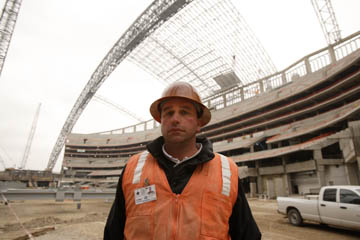 To get hired, a person needs to be 18, have a valid driver’s license and a vehicle to get to the job, and do three years at apprentice school. But school is only about 100 hours a semester, and apprentices are expected to work full time – at a starting pay of just over $13 an hour. When the three years are completed, an apprentice becomes a journeyman. Non-union workers with seven years’ experience can also join at the journeyman level. Other than the racial makeup of the local, the biggest change Smitherman has seen in his career, he said, are the safety regulations that the Occupational Safety and Health Administration (OSHA) put in place during the 1990s. The key measure was the one requiring anyone working six feet or more above the ground to wear a harness clipped to a safety wire. “Since they put that rule in, I think we’ve had just one man killed in the last 10 years, and that was when a section of wall fell on him,” Smitherman said. “We haven’t had anyone fall off a building in a long time.”
To get hired, a person needs to be 18, have a valid driver’s license and a vehicle to get to the job, and do three years at apprentice school. But school is only about 100 hours a semester, and apprentices are expected to work full time – at a starting pay of just over $13 an hour. When the three years are completed, an apprentice becomes a journeyman. Non-union workers with seven years’ experience can also join at the journeyman level. Other than the racial makeup of the local, the biggest change Smitherman has seen in his career, he said, are the safety regulations that the Occupational Safety and Health Administration (OSHA) put in place during the 1990s. The key measure was the one requiring anyone working six feet or more above the ground to wear a harness clipped to a safety wire. “Since they put that rule in, I think we’ve had just one man killed in the last 10 years, and that was when a section of wall fell on him,” Smitherman said. “We haven’t had anyone fall off a building in a long time.”
Still the job remains dangerous. “Hey, it’s always going to be dangerous. You’re working with girders and beams that weigh thousands of pounds, and even the smallest mistake can hurt a man badly,” he said. “And you’ve still got to be willing to walk out over open space, harness or not. So it’s still not a job for everybody.” He told about one new apprentice who quit before he arrived at his first job. Then Steve Anthony, the business agent, took a call from a member who also seemed to be looking for other options. Smitherman laughed. “Out of every 50 guys who sign up for apprentice school, probably 47 or 48 quit when they realize how tough this job is.” The Derr Steel Erection Company specializes in stadiums and arenas. Among their credits are the Washington, D.C., convention center, Houston’s Reliant Stadium, the San Antonio Spurs and Dallas Maverick arenas, the Ballpark in Arlington, and the new Indiana Colts stadium. Currently the company is building the retractable roof on the new Cowboys stadium.
The superintendent on that last job is Brian Isbell, whose dad is part-owner of Derr. Isbell is a fourth-generation ironworker, but even with his dad’s contacts he had to spend seven years on the road after his apprenticeship before he became a superintendent for Derr. “That’s a lot of time away from home,” he said, “but that’s ironwork. If you can’t live in a motel, you better find another job.” On the current job, he oversees 96 employees, from office workers to crane operators, welders, high-steel workers, and high-steel painters. Standing in the bowels of the construction site, one feels like a toy figure in the midst of a gigantic erector set. The stadium, floor to the roof, is 290 feet and will go higher once it’s completed. Two 1,300-foot-long steel arches will span the length of the stadium, though only one is completed.
Outside, cranes unload huge trucks carrying 20- and 30-foot-long steel beams, numbered to designate their positions in the building. The beams forming the arches are put together into sections 56 feet long and weighing about 125,000 pounds. Each section is then lifted into the air by a crane, put in position, and bolted to the previous section by men who, from the ground, look like ants. Other ants clamber about the glistening white beams, painting over the bolts and scratches to protect the beams from rust. A giant crane takes Derr foreman Alan Hurst up for a view from the top. The cramped basket has a waist-high metal mesh railing but is open above, and passengers tie safety harnesses to its corners. The crane swiftly lifts the basket to almost 300 feet – about the height of a 20-story building, nearly level with workers on the highest beams. A painter in coveralls works lying on his stomach, the lanyard of his harness seeming about as hefty as a length of string. Another worker is calmly walking up the sloped steel.
When Hurst tells the crane operator, by walkie-talkie, to move him closer to the unfinished arch, the basket swings across the field and up past the roof level to clear another crane, and suddenly the wind whistles through. The basket is blown sideways a couple of feet, spinning when the crane stops. The view goes for miles in all directions, over a vast sea of trees. On the stadium floor, people look like dots. “This is great up here, isn’t it?” Hurst says. One of the dots on the ground, introduced by Isbell later, is Gaylan Frank, called Pineapple, a small leathery fellow from Hawaii. He’s been working high steel for 28 years but is currently restricted to work on the ground because of an accident that threw off his equilibrium. “We were working the Colts stadium, and I went to help another crew out,” he explains. “Some rebar slipped and spun around and hit me in the temple. Fractured my skull in five places. I didn’t miss much work, but I did go into a pretty deep depression because I couldn’t go up on high steel anymore. But I’ll get back to 100 percent and be up there maybe in another six months or so.”
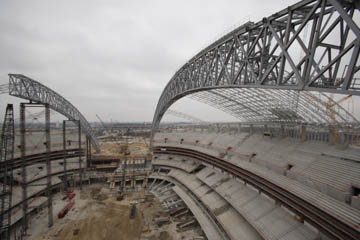 Up high, he says, “You can see forever. Nobody can bother you up there.” He doesn’t like bad weather, but that’s the job, and you just work through it. “And the travel – I used to love it, but that’s getting old. But I never got tired of being up there.”
Up high, he says, “You can see forever. Nobody can bother you up there.” He doesn’t like bad weather, but that’s the job, and you just work through it. “And the travel – I used to love it, but that’s getting old. But I never got tired of being up there.”
“Much as I loved it,” said Chrietzberg, “I don’t know if I’d still be ironworking even if I hadn’t broken my back. Something about having to wear those harnesses and being tied off all the time. How in the hell do you do structural ironwork like that? Seems to me it would make it more dangerous, not less, because you can’t move quickly if you have to. You might not fall off a girder anymore, but what about just getting hit? That’ll kill you just as quick.” “The industry has changed for sure,” said Gary White, known as Tennis Shoe during his 40 years in the trade. “When I was working, I always wanted to be on top of things. I sure didn’t want to be underneath anybody.”
After he retired from steelwork in 2000, White switched to job-site safety. And he credits harnesses and other OSHA changes with giving workers more confidence that they’ll be coming down in one piece whenever they go up. On the other hand, he said, a lot of the freedom is gone as well. “It used to be you lived up there by your guts. You couldn’t be afraid. Nowadays, heck, just about anybody can be an ironworker.” Leroy Self said that at least two sets of ironworkers generally ignore OSHA’s rules and get away with it – those who are working on vertical beam connections and the worker who sets the initial safety line. Neither, he said, has any place to hook a safety line. “That fellow walking out there putting up that safety cable, where is he supposed to tie off to? There’s nothing there. And the connectors, well, the guys shimmy up the beam and wait till a new beam comes in, then put a spud bar in place to keep the beam from moving. But they’ve got no place to hook their harnesses either. What are they going to do, hook it to the bolt holes? Hell, no.”
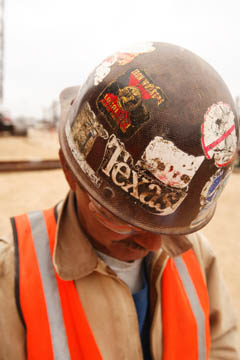 Self said that when he was working at a Chrysler plant, a supervisor ordered him to tell his team to hook onto a ladder they were using to set beams. “I told him, ‘No way. What if that ladder fell? Then what?’ And he tells me: ‘You’re right. Forget what I just told you.'” “My daddy,” said Rattlesnake Smith, “told me when I started working high steel that you have two hands – one for the contractor, one hand to hold onto something. So you’re only renting out one hand at a time.” But Smith said he misses the rush of high steel so much sometimes that he’s thinking about going back to work, putting wind turbines together. “Lot of my friends are working those towers, and they’re making pretty good pay,” he said. “And 400 feet is a good height to get to. “What you got to know is that there are three things about high-iron work: The thrill of the danger, the money, and the arrogance of knowing that you’re doing something very few people can do. “You have a job with those three things going for it, that’s a pretty good job.”
Self said that when he was working at a Chrysler plant, a supervisor ordered him to tell his team to hook onto a ladder they were using to set beams. “I told him, ‘No way. What if that ladder fell? Then what?’ And he tells me: ‘You’re right. Forget what I just told you.'” “My daddy,” said Rattlesnake Smith, “told me when I started working high steel that you have two hands – one for the contractor, one hand to hold onto something. So you’re only renting out one hand at a time.” But Smith said he misses the rush of high steel so much sometimes that he’s thinking about going back to work, putting wind turbines together. “Lot of my friends are working those towers, and they’re making pretty good pay,” he said. “And 400 feet is a good height to get to. “What you got to know is that there are three things about high-iron work: The thrill of the danger, the money, and the arrogance of knowing that you’re doing something very few people can do. “You have a job with those three things going for it, that’s a pretty good job.”
You can reach Peter Gorman at
peterg9@yahoo.com.




